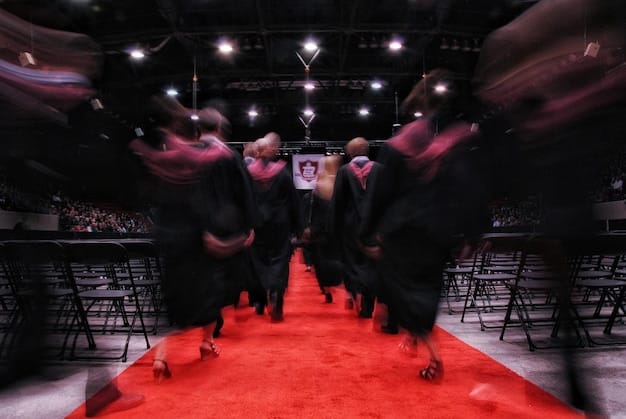US Award Show Ratings: Are They Declining and How to Reverse the Trend?

US award show ratings have been declining in recent years due to various factors such as changing viewing habits, increased competition from streaming services, and a disconnect with younger audiences; however, strategies like embracing digital platforms, diversifying content, and engaging with fans can revive interest and viewership.
Are US award show ratings in a slump? Let’s explore the reasons behind the decline and discuss potential solutions to bring the excitement back to these iconic events.
The Shifting Sands of Award Show Viewership
Award shows have long been a staple of American entertainment, but recent years have seen a noticeable dip in viewership. Understanding this decline requires a look at the evolving media landscape and changing consumer preferences.
The reasons behind this decline are complex and multifaceted.
The Rise of Streaming Services
The proliferation of streaming services has dramatically altered how people consume entertainment. With a vast library of content available on demand, viewers are less likely to tune into live broadcasts like award shows.
Fragmented Audience Attention
In the age of social media and short-form video content, attention spans are shorter, and audiences are more fragmented. Award shows must compete with countless other forms of entertainment vying for viewers’ time and attention.

The following points shed light on audience attention:
- Changing Viewing Habits: Fewer people are watching live TV.
- Content Overload: Too much to choose from dilutes interest.
- Social Media Distractions: Constant updates pull attention away.
These shifting dynamics pose a significant challenge to the traditional award show format, necessitating innovative approaches to recapture audience engagement.
The Culprits Behind the Ratings Drop
Several factors contribute to the decline in award show ratings, from changing demographics to content delivery methods. Identifying these culprits is the first step toward finding effective solutions.
Let’s delve deeply into the reasons that are making a difference.
Demographic Shifts
Younger demographics, in particular, have shown less interest in traditional award shows. Their viewing habits lean more towards digital platforms and personalized content recommendations, leading to a generational divide in viewership.
Lack of Diversity and Representation
Criticism regarding the lack of diversity and representation in nominations and awards has also contributed to the decline. Audiences are increasingly demanding more inclusive and diverse storytelling in entertainment.
Following are several points regarding lack of diversity and representation:
- Social Media Activism: Call-outs for more diversity affect perception.
- #OscarsSoWhite: Protests highlight representation concerns.
- Authenticity Matters: Viewers want stories that reflect their lives.
Relevance and Cultural Impact
Award shows need to maintain their relevance and cultural impact to attract and retain viewers. Failing to adapt to changing cultural norms and audience expectations can lead to a decline in engagement.

In order to make an impact, award shows may need to:
- Embrace relevant social causes: Highlight important social issues to connect with modern audiences.
- Utilize interactive platforms: Introduce live voting and interactive elements to engage viewers actively.
- Showcase diverse talent: Celebrate a wide range of artists, stories, and achievements to appeal to broader audiences.
Digital Platforms: A Double-Edged Sword
While digital platforms contribute to the fragmentation of audience attention, they also offer new opportunities for award shows to reach viewers. Leveraging these platforms effectively is crucial for reversing the ratings decline.
Despite some issues, digital platforms represent opportunity.
Streaming and Online Access
Providing streaming options and online access to award shows makes it easier for viewers to watch on their own terms. This flexibility appeals to those who may not have the time or inclination to tune into live broadcasts.
Social Media Engagement
Using social media platforms to engage with fans, share behind-the-scenes content, and create interactive experiences can boost excitement and build anticipation for the awards.
Short-Form Content
Producing short-form content, such as highlight reels and viral moments, can capture the attention of younger audiences who may not be interested in watching the entire show.
Strategies for Reversing the Trend
To reverse the decline in ratings, award shows must adapt to the changing media landscape, embrace new technologies, and cater to evolving audience preferences. Innovative strategies are needed to revitalize these iconic events.
There are several ways that award shows can rebound.
Embracing Digital Innovation
Award shows can utilize digital platforms to enhance the viewing experience by offering interactive features, behind-the-scenes content, and live Q&A sessions with nominees and winners.
Diversifying Content and Representation
Award shows should prioritize diversity and representation in nominations, awards, and content. Showcasing a wide range of talent and stories can attract a broader audience and promote inclusivity.
Enhancing Viewer Engagement
Award shows should find new ways to engage with viewers, such as incorporating fan voting, interactive polls, and social media challenges. Creating a sense of community and participation can boost excitement and engagement.
The Future of Award Shows
The future of award shows depends on their ability to adapt and innovate. By embracing new technologies, catering to diverse audiences, and enhancing viewer engagement, award shows can remain relevant and continue to celebrate the best in entertainment.
Here are some possible ways forward.
Personalized Viewing Experiences
Offering personalized viewing experiences, such as customizable content feeds and interactive features, can cater to individual preferences and enhance viewer engagement.
Hybrid Event Formats
Combining traditional live broadcasts with digital experiences can help award shows reach a wider audience and create a more immersive and engaging event.
Data-Driven Decision Making
Using data analytics to inform programming decisions, identify audience trends, and optimize content delivery can help award shows stay ahead of the curve and maximize viewership.
The Role of Celebrities and Influencers
Celebrities and influencers play a crucial role in driving viewership and engagement for award shows. Collaborating with these individuals can help boost excitement and attract new audiences.
Here are some areas where celebrities play a part
Social Media Promotion
Enlisting celebrities and influencers to promote the awards on social media can generate buzz and build anticipation for the event.
Red Carpet Coverage
Leveraging celebrity appearances on the red carpet to showcase fashion, promote new projects, and engage with fans can attract viewers and boost social media engagement.
On-Stage Performances and Appearances
Featuring celebrity performances and appearances throughout the show can liven up the broadcast and keep viewers engaged.
| Key Point | Brief Description |
|---|---|
| 📉 Ratings Decline | Viewership has dropped due to various factors. |
| 📱 Streaming Impact | Streaming services offer on-demand content. |
| 🌟 Celeb Influence | Celebrities drive viewership and engagement. |
| 🤝 Viewer Engagement | Enhance interaction with fan voting, polls. |
FAQ
▼
Award show ratings are declining primarily due to the rise of streaming services, fragmented audience attention, demographic shifts, and a lack of diversity and representation.
▼
Streaming services offer a vast library of on-demand content, giving viewers less incentive to watch live broadcasts like award shows. This shift in viewing habits has significantly impacted viewership.
▼
Social media distracts viewers and fragments attention spans. Short-form content and constant updates compete with the longer format of award shows, pulling viewers away from live broadcasts.
▼
Award shows can engage younger audiences by embracing digital innovation, using social media effectively, and offering streaming options. Creating personalized viewing experiences is another strategy.
▼
The future of award shows depends on their ability to adapt and innovate. Embracing new technologies, catering to diverse audiences, and enhancing viewer engagement are essential for remaining relevant.
Conclusion
In conclusion, reversing the decline in US award show ratings requires a multi-faceted approach that addresses changing viewing habits, embraces digital innovation, and enhances viewer engagement. By adapting to the evolving media landscape and prioritizing diversity and representation, award shows can recapture audience excitement and secure their place in entertainment culture for years to come.





